句型宝典完整版 (2)
句型宝典(完全版)
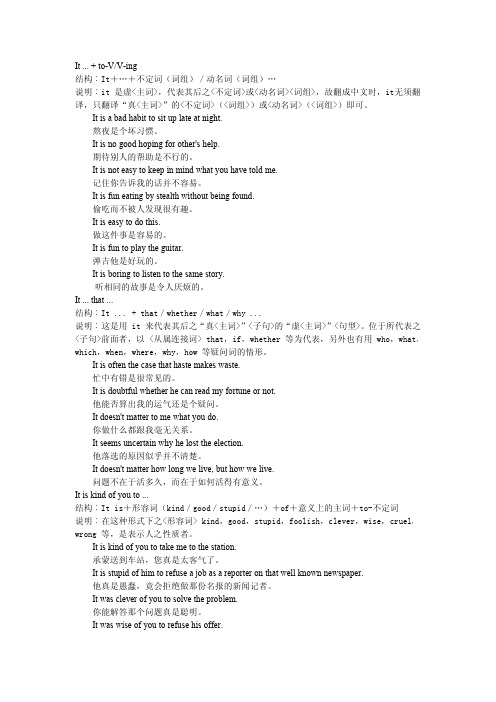
It...+to-V/V-ing结构︰It+…+不定词(词组)/动名词(词组)…说明︰it是虚<主词>,代表其后之<不定词>或<动名词><词组>,故翻成中文时,it无须翻译,只翻译“真<主词>”的<不定词>(<词组>)或<动名词>(<词组>)即可。
It is a bad habit to sit up late at night.熬夜是个坏习惯。
It is no good hoping for other's help.期待别人的帮助是不行的。
It is not easy to keep in mind what you have told me.记住你告诉我的话并不容易。
It is fun eating by stealth without being found.偷吃而不被人发现很有趣。
It is easy to do this.做这件事是容易的。
It is fun to play the guitar.弹吉他是好玩的。
It is boring to listen to the same story.听相同的故事是令人厌烦的。
It...that...结构︰It...+that/whether/what/why...说明︰这是用it来代表其后之“真<主词>”<子句>的“虚<主词>”<句型>。
位于所代表之<子句>前面者,以<从属连接词>that,if,whether等为代表,另外也有用who,what,which,when,where,why,how等疑问词的情形。
It is often the case that haste makes waste.忙中有错是很常见的。
It is doubtful whether he can read my fortune or not.他能否算出我的运气还是个疑问。
(完整版)简单句的五种基本句型讲解及练习题.doc
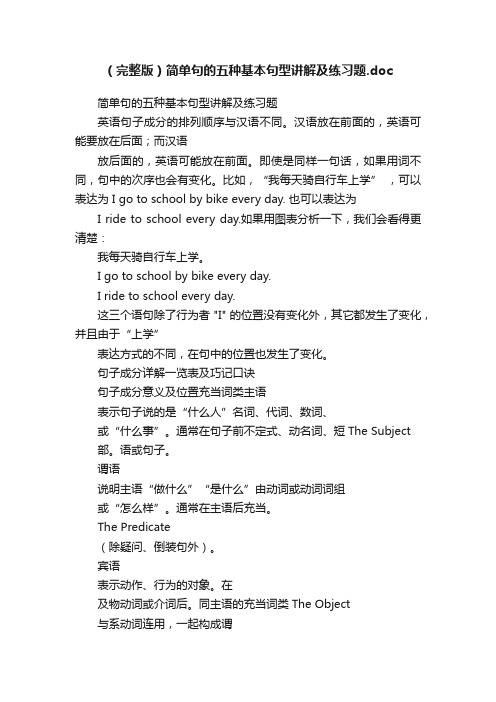
(完整版)简单句的五种基本句型讲解及练习题.doc简单句的五种基本句型讲解及练习题英语句子成分的排列顺序与汉语不同。
汉语放在前面的,英语可能要放在后面;而汉语放后面的,英语可能放在前面。
即使是同样一句话,如果用词不同,句中的次序也会有变化。
比如,“我每天骑自行车上学” ,可以表达为 I go to school by bike every day. 也可以表达为I ride to school every day.如果用图表分析一下,我们会看得更清楚:我每天骑自行车上学。
I go to school by bike every day.I ride to school every day.这三个语句除了行为者 "I" 的位置没有变化外,其它都发生了变化,并且由于“上学”表达方式的不同,在句中的位置也发生了变化。
句子成分详解一览表及巧记口诀句子成分意义及位置充当词类主语表示句子说的是“什么人”名词、代词、数词、或“什么事”。
通常在句子前不定式、动名词、短The Subject部。
语或句子。
谓语说明主语“做什么”“是什么”由动词或动词词组或“怎么样”。
通常在主语后充当。
The Predicate(除疑问、倒装句外)。
宾语表示动作、行为的对象。
在及物动词或介词后。
同主语的充当词类The Object与系动词连用,一起构成谓表语语部分、说明主语的性质、同主语的充当词类The Predicate 特征。
常在系动词之后。
用来修饰名词或代词。
单个形、代、数、名、介定语词常在修饰的词前,短语或词短语或相当于形The Attribute 句子在被修饰的词之后。
容词的词或短语。
状语修饰动词、形容词、副词,通常由副词、介词短表示动作发生的时间、地点、语或相当于副词的The Attribute目的、方式等。
位置较灵活。
词或短语来表示。
宾语补足语宾语的补足语,逻辑上与宾由形容词、名词、介The Object 语是“主谓”关系。
句型宝典完整版2
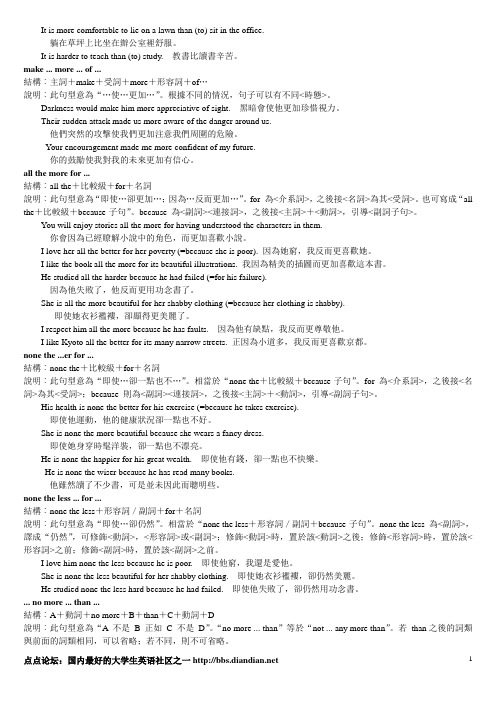
It is more comfortable to lie on a lawn than (to) sit in the office.躺在草坪上比坐在辦公室裡舒服。
It is harder to teach than (to) study. 教書比讀書辛苦。
make ... more ... of ...結構︰主詞+make+受詞+more+形容詞+of…說明︰此句型意為“…使…更加…”。
根據不同的情況,句子可以有不同<時態>。
Darkness would make him more appreciative of sight. 黑暗會使他更加珍惜視力。
Their sudden attack made us more aware of the danger around us.他們突然的攻擊使我們更加注意我們周圍的危險。
Your encouragement made me more confident of my future.你的鼓勵使我對我的未來更加有信心。
all the more for ...結構︰all the+比較級+for+名詞說明︰此句型意為“即使…卻更加…;因為…反而更加…”。
for 為<介系詞>,之後接<名詞>為其<受詞>。
也可寫成“all the+比較級+because-子句”。
because 為<副詞><連接詞>,之後接<主詞>+<動詞>,引導<副詞子句>。
You will enjoy stories all the more for having understood the characters in them.你會因為已經瞭解小說中的角色,而更加喜歡小說。
I love her all the better for her poverty (=because she is poor). 因為她窮,我反而更喜歡她。
中空英语书面表达模板(宝典句型、短语)
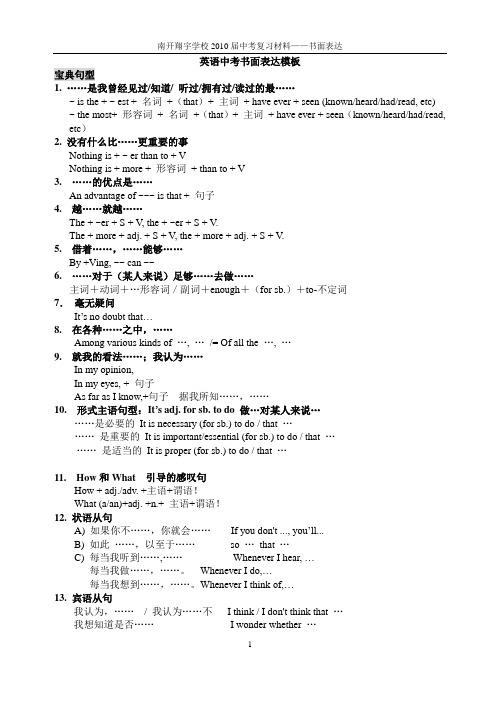
英语中考书面表达模板宝典句型1. ……是我曾经见过/知道/ 听过/拥有过/读过的最……~ is the + ~ est + 名词+(that)+ 主词+ have ever + seen (known/heard/had/read, etc) ~ the most+ 形容词+ 名词+(that)+ 主词+ have ever + seen(known/heard/had/read, etc)2. 没有什么比……更重要的事Nothing is + ~ er than to + VNothing is + more + 形容词+ than to + V3. ……的优点是……An advantage of ~~~ is that + 句子4. 越……就越……The + ~er + S + V, the + ~er + S + V.The + more + adj. + S + V, the + more + adj. + S + V.5. 借着……,……能够……By +Ving, ~~ can ~~6. ……对于(某人来说)足够……去做……主词+动词+…形容词/副词+enough+(for sb.)+to-不定词7.毫无疑问It’s no doubt that…8. 在各种……之中,……Among various kinds of …, …/= Of all the …, …9. 就我的看法……;我认为……In my opinion,In my eyes, + 句子As far as I know,+句子据我所知……,……10. 形式主语句型:It’s adj. for sb. to do 做…对某人来说………是必要的It is necessary (for sb.) to do / that ………是重要的It is important/essential (for sb.) to do / that ………是适当的It is proper (for sb.) to do / that …11. How和What 引导的感叹句How + adj./adv. +主语+谓语!What (a/an)+adj. +n.+ 主语+谓语!12. 状语从句A) 如果你不……,你就会……If you don't ..., you’ll...B) 如此……,以至于……so …that …C) 每当我听到……,……Whenever I hear, …每当我做……,……。
(完整版)英语句型大全
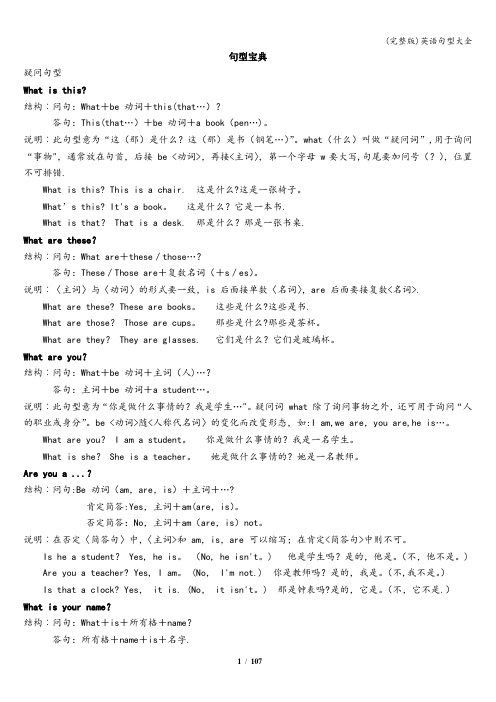
句型宝典疑问句型What is this?结构︰问句:What+be 动词+this(that…)?答句:This(that…)+be 动词+a book(pen…)。
说明︰此句型意为“这(那)是什么?这(那)是书(钢笔…)”。
what(什么)叫做“疑问词”,用于询问“事物",通常放在句首,后接 be <动词>,再接<主词〉,第一个字母 w要大写,句尾要加问号(?),位置不可排错.What is this? This is a chair. 这是什么?这是一张椅子。
What’s this? It's a book。
这是什么?它是一本书.What is that? That is a desk. 那是什么?那是一张书桌.What are these?结构︰问句:What are+these/those…?答句:These/Those are+复数名词(+s/es)。
说明︰〈主词〉与〈动词〉的形式要一致,is 后面接单数〈名词〉,are 后面要接复数<名词>.What are these? These are books。
这些是什么?这些是书.What are those? Those are cups。
那些是什么?那些是茶杯。
What are they? They are glasses. 它们是什么?它们是玻璃杯。
What are you?结构︰问句:What+be 动词+主词(人)…?答句:主词+be 动词+a student…。
说明︰此句型意为“你是做什么事情的?我是学生…"。
疑问词 what 除了询问事物之外,还可用于询问“人的职业或身分”。
be <动词>随<人称代名词〉的变化而改变形态,如:I am,we are,you are,he is…。
What are you? I am a student。
你是做什么事情的?我是一名学生。
英语口语语法假设句型
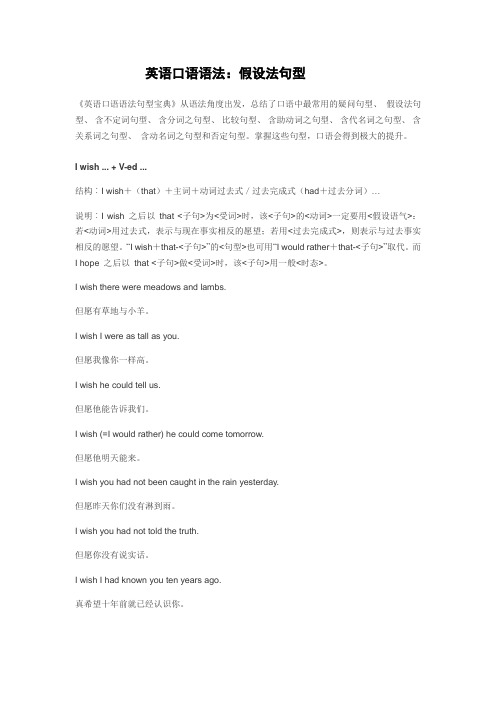
英语口语语法:假设法句型《英语口语语法句型宝典》从语法角度出发,总结了口语中最常用的疑问句型、假设法句型、含不定词句型、含分词之句型、比较句型、含助动词之句型、含代名词之句型、含关系词之句型、含动名词之句型和否定句型。
掌握这些句型,口语会得到极大的提升。
I wish ... + V-ed ...结构︰I wish+(that)+主词+动词过去式/过去完成式(had+过去分词)…说明︰I wish 之后以that <子句>为<受词>时,该<子句>的<动词>一定要用<假设语气>:若<动词>用过去式,表示与现在事实相反的愿望;若用<过去完成式>,则表示与过去事实相反的愿望。
“I wish+that-<子句>”的<句型>也可用“I would rather+that-<子句>”取代。
而I hope 之后以that <子句>做<受词>时,该<子句>用一般<时态>。
I wish there were meadows and lambs.但愿有草地与小羊。
I wish I were as tall as you.但愿我像你一样高。
I wish he could tell us.但愿他能告诉我们。
I wish (=I would rather) he could come tomorrow.但愿他明天能来。
I wish you had not been caught in the rain yesterday.但愿昨天你们没有淋到雨。
I wish you had not told the truth.但愿你没有说实话。
I wish I had known you ten years ago.真希望十年前就已经认识你。
If only + V-ed结构︰If only+过去式/过去完成式说明︰此句型意为“要是…就好了。
英语句型大全
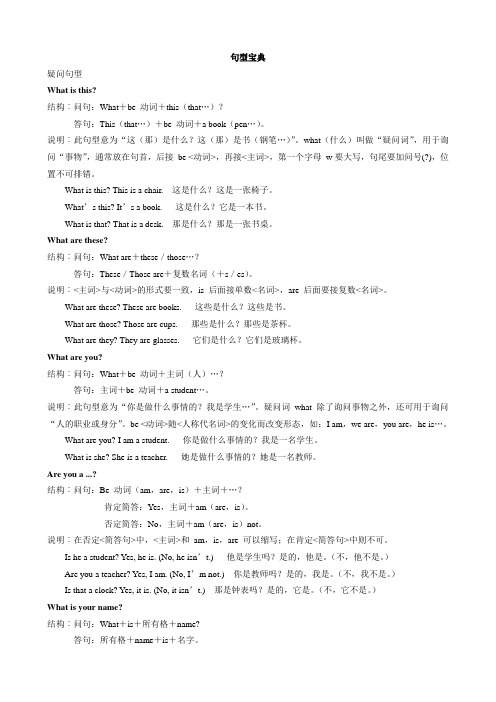
句型宝典疑问句型What is this?结构︰问句:What+be 动词+this(that…)?答句:This(that…)+be 动词+a book(pen…)。
说明︰此句型意为“这(那)是什么?这(那)是书(钢笔…)”。
what(什么)叫做“疑问词”,用于询问“事物”,通常放在句首,后接be <动词>,再接<主词>,第一个字母w要大写,句尾要加问号(?),位置不可排错。
What is this? This is a chair. 这是什么?这是一张椅子。
What’s this? It’s a book. 这是什么?它是一本书。
What is that? That is a desk. 那是什么?那是一张书桌。
What are these?结构︰问句:What are+these/those…?答句:These/Those are+复数名词(+s/es)。
说明︰<主词>与<动词>的形式要一致,is 后面接单数<名词>,are 后面要接复数<名词>。
What are these? These are books. 这些是什么?这些是书。
What are those? Those are cups. 那些是什么?那些是茶杯。
What are they? They are glasses. 它们是什么?它们是玻璃杯。
What are you?结构︰问句:What+be 动词+主词(人)…?答句:主词+be 动词+a student…。
说明︰此句型意为“你是做什么事情的?我是学生…”。
疑问词what 除了询问事物之外,还可用于询问“人的职业或身分”。
be <动词>随<人称代名词>的变化而改变形态,如:I am,we are,you are,he is…。
What are you? I am a student. 你是做什么事情的?我是一名学生。
(完整版)英语句型大全
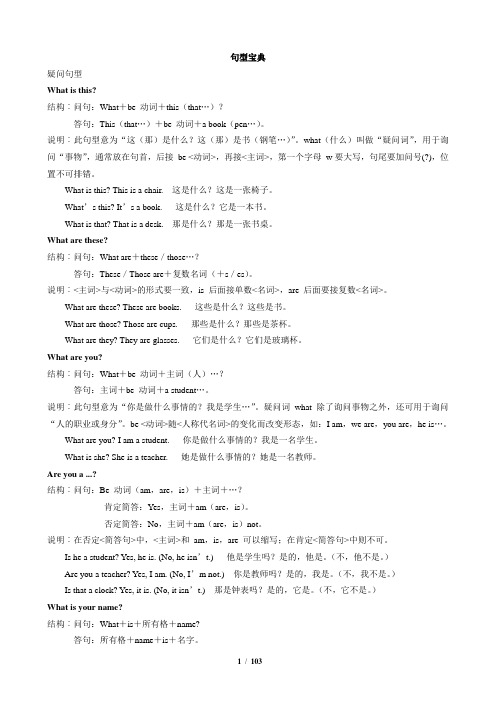
句型宝典疑问句型What is this?结构︰问句:What+be 动词+this(that…)?答句:This(that…)+be 动词+a book(pen…)。
说明︰此句型意为“这(那)是什么?这(那)是书(钢笔…)”。
what(什么)叫做“疑问词”,用于询问“事物”,通常放在句首,后接be <动词>,再接<主词>,第一个字母w要大写,句尾要加问号(?),位置不可排错。
What is this? This is a chair. 这是什么?这是一张椅子。
What’s this? It’s a book. 这是什么?它是一本书。
What is that? That is a desk. 那是什么?那是一张书桌。
What are these?结构︰问句:What are+these/those…?答句:These/Those are+复数名词(+s/es)。
说明︰<主词>与<动词>的形式要一致,is 后面接单数<名词>,are 后面要接复数<名词>。
What are these? These are books. 这些是什么?这些是书。
What are those? Those are cups. 那些是什么?那些是茶杯。
What are they? They are glasses. 它们是什么?它们是玻璃杯。
What are you?结构︰问句:What+be 动词+主词(人)…?答句:主词+be 动词+a student…。
说明︰此句型意为“你是做什么事情的?我是学生…”。
疑问词what 除了询问事物之外,还可用于询问“人的职业或身分”。
be <动词>随<人称代名词>的变化而改变形态,如:I am,we are,you are,he is…。
What are you? I am a student. 你是做什么事情的?我是一名学生。
英语句型学习宝典完整版(doc 90页)
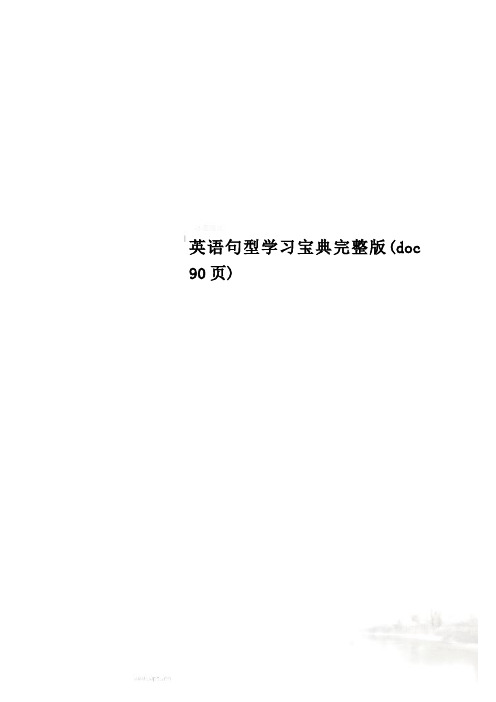
英语句型学习宝典完整版(doc 90页)句型宝典疑問句型What is this?結構︰問句:What+be 動詞+this(that…)?答句:This(that…)+be 動詞+a book (pen…)。
說明︰此句型意為“這(那)是什麼?這(那)是書(鋼筆…)”。
what(什麼)叫做“疑問詞”,用於詢問“事物”,通常放在句首,後接be <動詞>,再接<主詞>,第一個字母w要大寫,句尾要加問號(?),位置不可排錯。
What is this? This is a chair. 這是什麼?這是一張椅子。
What’s this? It’s a book. 這是什麼?它是一本書。
What is that? That is a desk. 那是什麼?那是一張書桌。
What are these?結構︰問句:What are+these/those…?答句:These/Those are+複數名詞(+s /es)。
說明︰<主詞>與<動詞>的形式要一致,is 後面接單數<名詞>,are 後面要接複數<名詞>。
What are these? These are books. 這些是什麼?這些是書。
What are those? Those are cups. 那些是什麼?那些是茶杯。
What are they? They are glasses. 它們是什麼?它們是玻璃杯。
What are you?結構︰問句:What+be 動詞+主詞(人)…?答句:主詞+be 動詞+a student…。
說明︰此句型意為“你是做什麼事情的?我是學生…”。
疑問詞what 除了詢問事物之外,還可用於詢問“人的職業或身分”。
be <動詞>隨<人稱代名詞>的變化而改變形態,如:I am,we are,you are,he is…。
What are you? I am a student. 你是做什麼事情的?我是一名學生。
八年级上 宝典训练Unit1
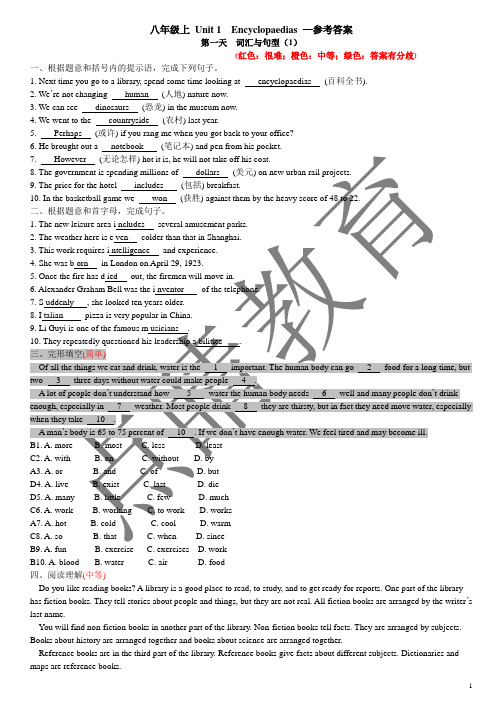
八年级上Unit 1 Encyclopaedias —参考答案第一天词汇与句型(1)(红色:很难;橙色:中等;绿色:答案有分歧)一、根据题意和括号内的提示语,完成下列句子。
1. Next time you go to a library, spend some time looking at encyclopaedias (百科全书).2. We’re not changing human (人地) nature now.3. We can see dinosaurs (恐龙) in the museum now.4. We went to the countryside (农村) last year.5. Perhaps (或许) if you rang me when you got back to your office?6. He brought out a notebook (笔记本) and pen from his pocket.B9. A. fun B. exercise C. exercises D. workB10. A. blood B. water C. air D. food四、阅读理解(中等)Do you like reading books? A library is a good place to read, to study, and to get ready for reports. One part of the library has fiction books. They tell stories about people and things, but they are not real. All fiction books are arranged by the writer’s last name.You will find non-fiction books in another part of the library. Non-fiction books tell facts. They are arranged by subjects. Books about history are arranged together and books about science are arranged together.Reference books are in the third part of the library. Reference books give facts about different subjects. Dictionaries and maps are reference books.Inside the cover of each library book is a pocket with a card. The card has the name of the book and the writer’s name. when you borrow a book, the librarian writers down your library card number.A1. According to the passage, how many parts does a library have?A. Three.B. Two.C. Four.D. Five.A2. The books about Monkey King will be put in the _____.A. fiction partB. non-fiction partC. reference partD. library cardD3. If you want to look up a new word, you should go to the ____.A. science partB. fiction partC. non-fiction partD. reference partC4. What does the underlined word “librarian” mean in Chinese?A. 作家B. 校长C. 图书馆理员D. 图书馆馆长3.theto ask the好奇心), come in and look round. Price: twenty dollars." Mr. Smith was sure that the visitors would 8 coming, but he was wrong. More and more visitors came and Mr. Smith had to 9 every day showing them around his house. “I came here to 10 not to work as a guide," he said angrily. In the end, he sold the house and moved away.C1. A. garden B. shop C. house D. schoolA2. A. liked B. hated C. sold D. builtB3. A. big B. interesting C. small D. cleanD4. A. children B. students C. parents D. touristsC5. A. no B. none C. many D. muchB6. A. come B. leave C. stay D. playA7. A. satisfy B. surprise C. interest D. exciteB8. A. go on B. stop C. continue D. notC9. A. take B. cost C. spend D. payD10. A. play B. work C. watch D. retire四、阅读理解(简单)Bruno was a boy of eight. His father worked in a cinema and his mother worked in a shop. He lived not far from his school. He always walked there and walked home. On his way to school, he had to pass a playground. It was very wet after it rained. One day, when he got home, his clothes were all wet. His mother became angry(生气的)and said,“Don’t play in the water on your way home from school!”On the next day Bruno came home with wet and dirty(脏的)clothes. His mother became even angrier. “I’ll tell your father if you come back wet again,” said his mother. “He’ll punish(惩罚)You, you know.”““’tB9. When I was young, I ____ keep a ____. I wrote many poems in it.A. was used to, notebookB. used to, notebookC. was used to, inventionD. used to, dollarD10. Dinosaurs ____ long time ago and some of them were very huge. ____ were as small as chickens.A. died of, othersB. died from, the othersC. died out, the othersD. died out, othersB11. He, _______, is good at drawing. He likes painting some _____ drawing.A. such as, interestingB. for example, interestingC. such as, interestedD. for example, interestedA12. From an early age, Leonardo da Vince showed great ____ and ____ ability.A. intelligence, artisticB. intelligence, artistC. intelligent, artD. intelligent, musicianD13. Leonardo da Vince was _____. He came from ____.A. French, FranceB. English, EnglandC. Italian, ItalianD. Italian, ItalyD14. Walt Disney was born _____ the USA ____ Mar 12th 1901.A. in, atB. at, inC. in, inD. in, onA15. She is 14 years old and also 14 years old. That means she is ____ I.A. the same age asB. same age withC. as tall asD. as same age as三、完形填空(简单)There was a pretty girl. Her name was Nancy. She was born 1 Beijing. She had two big eyes and short hair. She was 2 in Chinese and she loved writing.When she was in Grade 8, she got seriously ill. Her doctor said she would 3 her life anytime, but she wasn’t afraid of death. She 4 on studying and writing. 5 , she died on August 13, 2007 when she just finished the third year in university. She smiled 6 the end of her life.m alwaysA. Hong KongB. ShanghaiC. MoscowD. ChengduD3. It will take you ____ to reach England if you stop in Hong Kong.A. nine hours and twentyB. ten hours and thirty-fiveC. twelve hours and fiftyD. ten hours and forty-fiveA4. You may ____ in Beijing if you want to go to America.A. take one planeB. take two planesC. take three planesD. not take any planesB5. How many planes may you take in Beijing if you want to go to Australia?A. OneB. TwoC. ThreeD. Four第四天语法(1)一、单项选择。
英语学习句型宝典完整版
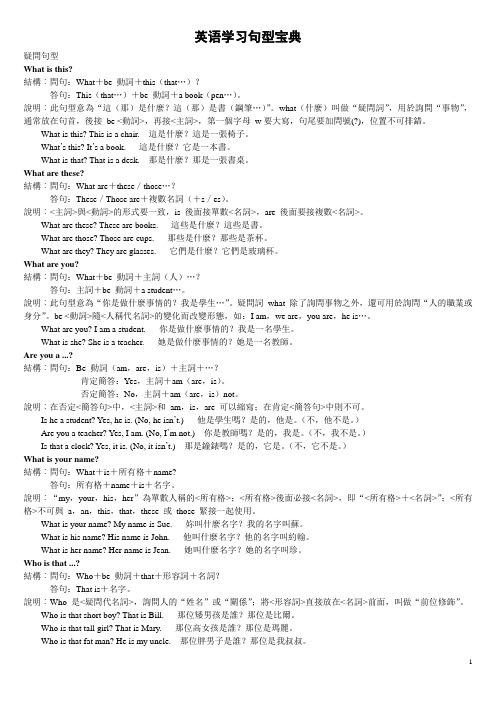
英语学习句型宝典疑問句型What is this?結構︰問句:What+be 動詞+this(that…)?答句:This(that…)+be 動詞+a book(pen…)。
說明︰此句型意為“這(那)是什麼?這(那)是書(鋼筆…)”。
what(什麼)叫做“疑問詞”,用於詢問“事物”,通常放在句首,後接be <動詞>,再接<主詞>,第一個字母w要大寫,句尾要加問號(?),位置不可排錯。
What is this? This is a chair. 這是什麼?這是一張椅子。
What’s this? It’s a book. 這是什麼?它是一本書。
What is that? That is a desk. 那是什麼?那是一張書桌。
What are these?結構︰問句:What are+these/those…?答句:These/Those are+複數名詞(+s/es)。
說明︰<主詞>與<動詞>的形式要一致,is 後面接單數<名詞>,are 後面要接複數<名詞>。
What are these? These are books. 這些是什麼?這些是書。
What are those? Those are cups. 那些是什麼?那些是茶杯。
What are they? They are glasses. 它們是什麼?它們是玻璃杯。
What are you?結構︰問句:What+be 動詞+主詞(人)…?答句:主詞+be 動詞+a student…。
說明︰此句型意為“你是做什麼事情的?我是學生…”。
疑問詞what 除了詢問事物之外,還可用於詢問“人的職業或身分”。
be <動詞>隨<人稱代名詞>的變化而改變形態,如:I am,we are,you are,he is…。
What are you? I am a student. 你是做什麼事情的?我是一名學生。
高考英语读后续写高分宝典:专题02 2024浙江首考卷读后续写(一英里长跑)讲义及满分语料 解析版
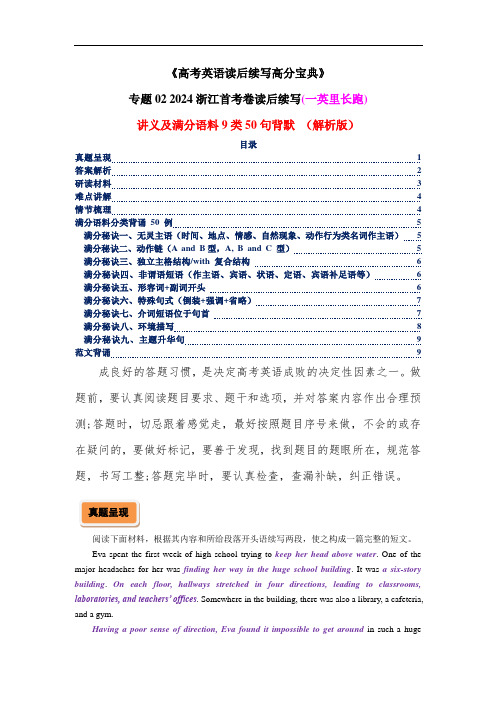
《高考英语读后续写高分宝典》专题02 2024浙江首考卷读后续写(一英里长跑)讲义及满分语料9类50句背默(解析版)目录真题呈现 1 答案解析 2 研读材料 3 难点讲解 4 情节梳理 4 满分语料分类背诵50例 5 满分秘诀一、无灵主语(时间、地点、情感、自然现象、动作行为类名词作主语) 5 满分秘诀二、动作链(A and B型,A, B and C 型) 5 满分秘诀三、独立主格结构/with复合结构 6 满分秘诀四、非谓语短语(作主语、宾语、状语、定语、宾语补足语等) 6 满分秘诀五、形容词+副词开头 6 满分秘诀六、特殊句式(倒装+强调+省略)7 满分秘诀七、介词短语位于句首7 满分秘诀八、环境描写8 满分秘诀九、主题升华句9 范文背诵9成良好的答题习惯,是决定高考英语成败的决定性因素之一。
做题前,要认真阅读题目要求、题干和选项,并对答案内容作出合理预测;答题时,切忌跟着感觉走,最好按照题目序号来做,不会的或存在疑问的,要做好标记,要善于发现,找到题目的题眼所在,规范答题,书写工整;答题完毕时,要认真检查,查漏补缺,纠正错误。
阅读下面材料,根据其内容和所给段落开头语续写两段,使之构成一篇完整的短文。
Eva spent the first week of high school trying to keep her head above water. One of the major headaches for her was finding her way in the huge school building. It was a six-story building. On each floor, hallways stretched in four directions, leading to classrooms, laboratories, and teachers’ offices. Somewhere in the building, there was also a library, a cafeteria, and a gym.Having a poor sense of direction, Eva found it impossible to get around in such a hugebuilding. All the different hallways and rooms were too much to think about, let alone commit to memory. She decided that she would memorize where her classes were and then pretend that the rest of the place didn’t exist.In her fast P.E. class, Eva was shocked when Coach Pitt announced that everyone had to run one mile around the track outside. She searched the faces of her classmates for signs of panic. There was nothing she feared more than having to run a whole mile.To Eva, “a mile” was u sed to describe long distances. It was ten miles from her home to her grandfather’s, and that always seemed like a long way, even in a car!When Coach Pitt blew his whistle (哨子),Eva figured she would be left in the dust. However, w hile some of her classmates edged ahead, others actually fell behind. “It’s just the beginning,” she thought. “I’ll come in last for sure.”Soon Eva began to breathe hard, with her heart pounding and legs shaking. Feeling desperate, Eva started using a mind wick on herself. She s topped thinking about the word “mile.” Instead, she focused on reaching the shadow east on the track by an oak tree up ahead. Then she concentrated on jogging to the spot where the track curved (拐弯). After that, she tried to see if she could complete her first lap. One lap turned into two, then three, then four.Paragraph1:When Coach Pitt said “Nice work!” to her at the finish line, Eva was surprised._______________________________________________________________________________ _______________________________________________________________________________ _______________________________________________________________________________ Paragraph2:Eva decided to use the same trick to deal with the school building._______________________________________________________________________________ _______________________________________________________________________________ _______________________________________________________________________________In the vast expanse of her school, a girl with poor directional skills struggled to navigate and often got lost. One day, during gym class, she observed a unique way to find her way - following the shadows of trees.As the sun cast its rays, the girl noticed how the shadows created patterns on the ground, guiding her path. She took a leap of faith and followed the shadows, surprising herself with each turn and stretch. Her efforts were noticed by the teacher, who praised her innovative thinking.Eva decided to use the same trick to deal with the school building. She used the shadows to navigate the school hallways, find her classes, and even locate the school's various facilities. This newfound skill not only helped the girl navigate her school but also instilled in her a sense of confidence and adventure. She learned excitedly that with a little creativity and observation, any challenge could be overcome. And with each step she too k, she left behind a legacy of inspirationfor those who followed in her footsteps, knowing that even without a clear sense of direction, there's always a way to find one's way.【解析】【导语】本文以人物为线索展开,讲述了高中生Eva因为方向感不强,经常在学校里迷路,在一次体育课上教练要求他们沿着校园跑步的时候Eva发现跟着树的影子能找到方向,她通过这个方法重新认识到了校园。
专题 2 句子成分和结构 -2023年暑假初升高英语衔接宝典(新高一适用)

专题 2 句子的成分与结构知识对接接点1句子成分英语的句子成分主要有七种:主语、谓语、宾语、表语、定语、状语和补语。
除了这七种主要成分之外,还有同位语和独立成分的说法。
其中独立成分与句子的其他成分没有语法上的联系,能用作独立成分的有感叹语、呼语和插入语。
接点2简单句的五种基本结构1.句子的基本结构可以归纳成五种基本句型。
掌握这五种基本句型,是掌握各种句子结构的基础。
2.五种基本句型结构如下:①S V(主+谓)He never lies.他从不撒谎。
②S V O(主+谓十宾)I like apples very much.我非常喜欢苹果。
③S V IO DO(主+谓+间宾+直宾)My parents bought me a new backpack.我父母给我买了一个新书包。
④S V O OC(主+谓+宾+宾补)I saw a boy playing basketball.我看见一个男孩正在打篮球。
⑤S V P(主+系+表)The milk went sour.牛奶变味了。
注:主语(Subject) 谓语(Predicate) 宾语(Object)定语(Attribute) 状语(Adverbial) 补语(Complement) 表语(Predicative)难点突破突破1主语主语是一个句子所叙述的主体,一般位于句首。
可以作主语的有名词、代词、数词、名词化的形容词(如the rich)、动词不定式、动名词、主语从句等。
Tom is a clever boy.(人名作主语)拓展训练用下划线画出下列句子的主语,并说明其所属的词性或语法结构1.During the 1990s, American country music has become more and more popular.2. We often speak English in class.3. One-third of the students in this class are girls.4. To swim in the pool is a great pleasure.5.Smoking does harm to the health.6.The rich should help the poor.7.When we are going to have an English test has not been decided.8.It is necessary to master a foreign language.9. That he isn't at home is not true.答案:1. During the 1990s,American country music has become more and more popular,(名词短语)2.We often speak English in class.(代词)3.One-third of the students in this class are girls.(数词)4.To swim in the pool is a great pleasure.(动词不定式)5.Smoking does harm to the health.(动名词)6.The rich should help the poor.(名词化的形容词)7.When we are going to have an English test has not been decided.(主语从句)8.It is necessary to master a foreign language.(It为代词,作形式主语,真正的主语为后面的动词不定式)9.That he isn't at home is not true.(主语从句)突破2谓语谓语通常由动词充当,说明主语所做的动作或具有的特征和状态,一般放在主语之后。
句型宝典
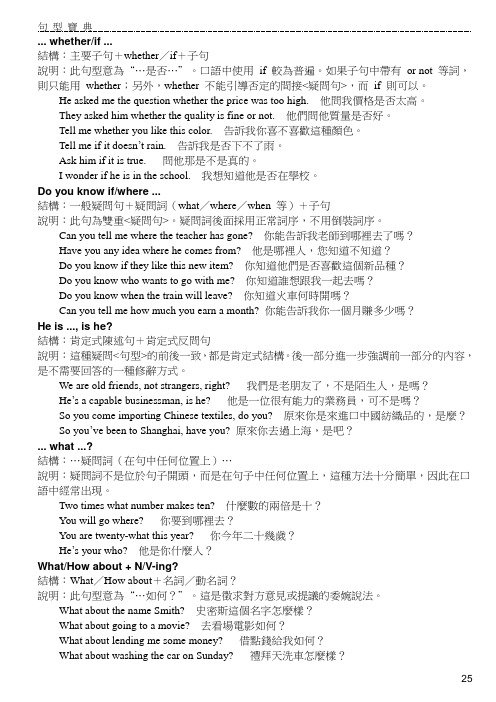
... whether/if ...結構︰主要子句+whether/if+子句說明︰此句型意為“…是否…”。
口語中使用if 較為普遍。
如果子句中帶有or not 等詞,則只能用whether;另外,whether 不能引導否定的間接<疑問句>,而if 則可以。
He asked me the question whether the price was too high. 他問我價格是否太高。
They asked him whether the quality is fine or not. 他們問他質量是否好。
Tell me whether you like this color. 告訴我你喜不喜歡這種顏色。
Tell me if it doesn’t rain. 告訴我是否下不了雨。
Ask him if it is true. 問他那是不是真的。
I wonder if he is in the school. 我想知道他是否在學校。
Do you know if/where ...結構︰一般疑問句+疑問詞(what/where/when 等)+子句說明︰此句為雙重<疑問句>。
疑問詞後陎採用正常詞序,不用倒裝詞序。
Can you tell me where the teacher has gone? 你能告訴我老師到哪裡去了嗎?Have you any idea where he comes from? 他是哪裡人,您知道不知道?Do you know if they like this new item? 你知道他們是否喜歡這個新品種?Do you know who wants to go with me? 你知道誰想跟我一起去嗎?Do you know when the train will leave? 你知道火車何時開嗎?Can you tell me how much you earn a month? 你能告訴我你一個月賺多少嗎?He is ..., is he?結構︰肯定式陳述句+肯定式反問句說明︰這種疑問<句型>的前後一致,都是肯定式結構。
最新英语句型宝典
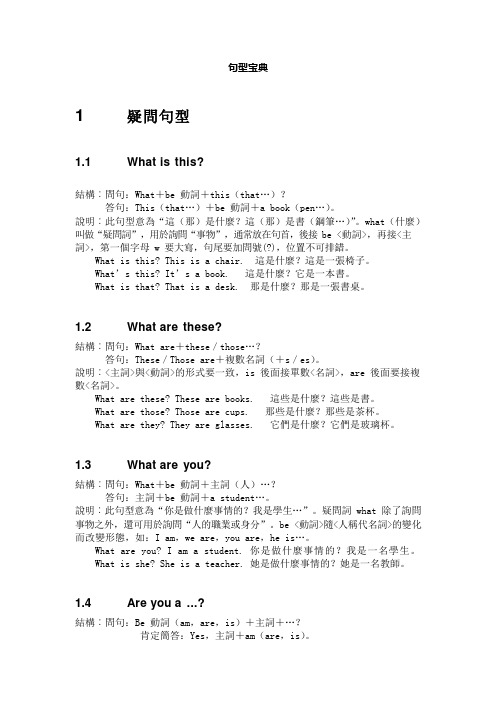
句型宝典1 疑問句型1.1 What is this?結構︰問句:What+be 動詞+this(that…)?答句:This(that…)+be 動詞+a book(pen…)。
說明︰此句型意為“這(那)是什麼?這(那)是書(鋼筆…)”。
what(什麼)叫做“疑問詞”,用於詢問“事物”,通常放在句首,後接 be <動詞>,再接<主詞>,第一個字母 w 要大寫,句尾要加問號(?),位置不可排錯。
What is this? This is a chair. 這是什麼?這是一張椅子。
What’s this? It’s a book.這是什麼?它是一本書。
What is that? That is a desk. 那是什麼?那是一張書桌。
1.2 What are these?結構︰問句:What are+these/those…?答句:These/Those are+複數名詞(+s/es)。
說明︰<主詞>與<動詞>的形式要一致,is 後面接單數<名詞>,are 後面要接複數<名詞>。
What are these? These are books. 這些是什麼?這些是書。
What are those? Those are cups. 那些是什麼?那些是茶杯。
What are they? They are glasses. 它們是什麼?它們是玻璃杯。
1.3 What are you?結構︰問句:What+be 動詞+主詞(人)…?答句:主詞+be 動詞+a student…。
說明︰此句型意為“你是做什麼事情的?我是學生…”。
疑問詞 what 除了詢問事物之外,還可用於詢問“人的職業或身分”。
be <動詞>隨<人稱代名詞>的變化而改變形態,如:I am,we are,you are,he is…。
What are you? I am a student. 你是做什麼事情的?我是一名學生。
(完整版)英语句型大全
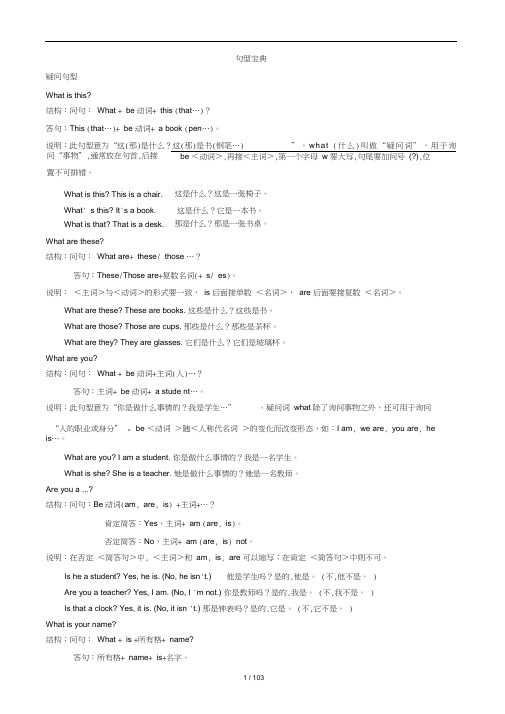
句型宝典疑问句型What is this?结构:问句:What + be动词+ this (that…)?答句:This (that…)+ be 动词+ a book (pen…)。
说明:此句型意为“这(那)是什么?这(那)是书(钢笔…)”。
what (什么)叫做“疑问词”,用于询be <动词>,再接<主词>,第一个字母w 要大写,句尾要加问号(?),位问“事物”,通常放在句首,后接置不可排错。
What is this? This is a chair. 这是什么?这是一张椅子。
What' s this? It's a book. 这是什么?它是一本书。
What is that? That is a desk. 那是什么?那是一张书桌。
What are these?结构:问句:What are+ these/ those …?答句:These/Those are+复数名词(+ s/ es)。
说明:<主词>与<动词>的形式要一致,is 后面接单数<名词>,are 后面要接复数<名词>。
What are these? These are books. 这些是什么?这些是书。
What are those? Those are cups. 那些是什么?那些是茶杯。
What are they? They are glasses. 它们是什么?它们是玻璃杯。
What are you?结构:问句:What + be动词+主词(人)…?答句:主词+ be动词+ a stude nt…。
说明:此句型意为“你是做什么事情的?我是学生…”。
疑问词what除了询问事物之外,还可用于询问“人的职业或身分” 。
be <动词>随<人称代名词>的变化而改变形态,如:I am, we are, you are, he is…。
What are you? I am a student. 你是做什么事情的?我是一名学生。
(2021年整理)新概念2(句型宝典)word版
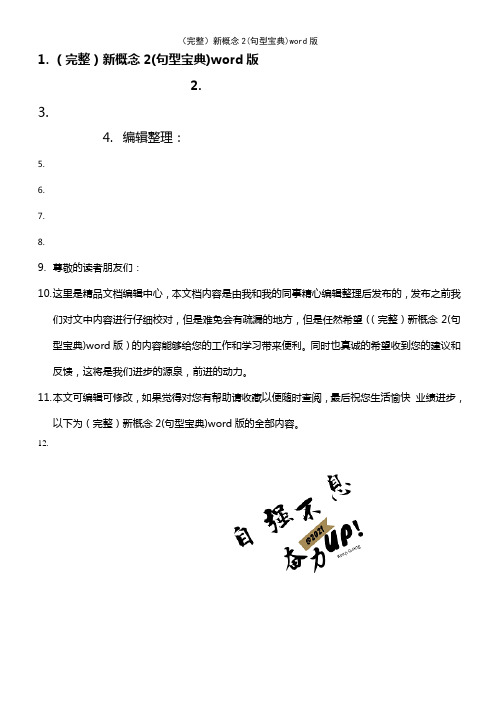
1.(完整)新概念2(句型宝典)word版2.3.4.编辑整理:5.6.7.8.9.尊敬的读者朋友们:10.这里是精品文档编辑中心,本文档内容是由我和我的同事精心编辑整理后发布的,发布之前我们对文中内容进行仔细校对,但是难免会有疏漏的地方,但是任然希望((完整)新概念2(句型宝典)word版)的内容能够给您的工作和学习带来便利。
同时也真诚的希望收到您的建议和反馈,这将是我们进步的源泉,前进的动力。
11.本文可编辑可修改,如果觉得对您有帮助请收藏以便随时查阅,最后祝您生活愉快业绩进步,以下为(完整)新概念2(句型宝典)word版的全部内容。
12.13.I could not bear it。
我受不了啦.锁定原文:NCE2-L1句型升级:第34课: I could not bear it anymore。
第38课:It was more than I could bear。
第52课:This is as far as I could bear.及时操练:婚宴上被人劝酒,大喊:我再也不能喝啦!请对这句话进行三次升级1,I can not drink anymore.2,It is more than I can drink.3,This is as far as I can drink。
It’s none of your business.不关你的事。
NCE2-L1Last week I went to the theatre。
I had a very good seat. The play was very interesting. I did not enjoy it. A young man and a young woman were sitting behind me。
They were talking loudly. I got very angry。
I could not hear the actors. I turned round. I looked at the man and the woman angrily. They did not pay any attention. In the end,I could not bear it. I turned round again. 'I can't he ar a word!’ I said angrily。
- 1、下载文档前请自行甄别文档内容的完整性,平台不提供额外的编辑、内容补充、找答案等附加服务。
- 2、"仅部分预览"的文档,不可在线预览部分如存在完整性等问题,可反馈申请退款(可完整预览的文档不适用该条件!)。
- 3、如文档侵犯您的权益,请联系客服反馈,我们会尽快为您处理(人工客服工作时间:9:00-18:30)。
句型宝典疑问句型What is this?结构︰问句:What+be 动词+this(that…)?答句:This(that…)+be 动词+a book(pen…)。
说明︰此句型意为“这(那)是什么?这(那)是书(钢笔…)”。
what(什么)叫做“疑问词”,用于询问“事物”,通常放在句首,后接be <动词>,再接<主词>,第一个字母w要大写,句尾要加问号(?),位置不可排错。
What is this? This is a chair. 这是什么?这是一张椅子。
What’s this? It’s a book. 这是什么?它是一本书。
What is that? That is a desk. 那是什么?那是一张书桌。
What are these?结构︰问句:What are+these/those…?答句:These/Those are+复数名词(+s/es)。
说明︰<主词>与<动词>的形式要一致,is 后面接单数<名词>,are 后面要接复数<名词>。
What are these? These are books. 这些是什么?这些是书。
What are those? Those are cups. 那些是什么?那些是茶杯。
What are they? They are glasses. 它们是什么?它们是玻璃杯。
What are you?结构︰问句:What+be 动词+主词(人)…?答句:主词+be 动词+a student…。
说明︰此句型意为“你是做什么事情的?我是学生…”。
疑问词what 除了询问事物之外,还可用于询问“人的职业或身分”。
be <动词>随<人称代名词>的变化而改变形态,如:I am,we are,you are,he is…。
What are you? I am a student. 你是做什么事情的?我是一名学生。
What is she? She is a teacher. 她是做什么事情的?她是一名教师。
Are you a ...?结构︰问句:Be 动词(am,are,is)+主词+…?肯定简答:Yes,主词+am(are,is)。
否定简答:No,主词+am(are,is)not。
说明︰在否定<简答句>中,<主词>和am,is,are 可以缩写;在肯定<简答句>中则不可。
Is he a student? Yes, he is. (No, he isn’t.) 他是学生吗?是的,他是。
(不,他不是。
)Are you a teacher? Yes, I am. (No, I’m not.) 你是教师吗?是的,我是。
(不,我不是。
)Is that a clock? Yes, it is. (No, it isn’t.) 那是钟表吗?是的,它是。
(不,它不是。
)What is your name?结构︰问句:What+is+所有格+name?答句:所有格+name+is+名字。
说明︰“my,your,his,her”为单数人称的<所有格>;<所有格>后面必接<名词>,即“<所有格>+<名词>”;<所有格>不可与a,an,this,that,these 或those 紧接一起使用。
What is your name? My name is Sue. 妳叫什么名字?我的名字叫苏。
What is his name? His name is John. 他叫什么名字?他的名字叫约翰。
What is her name? Her name is Jean. 她叫什么名字?她的名字叫珍。
Who is that ...?结构︰问句:Who+be 动词+that+形容词+名词?答句:That is+名字。
说明︰Who 是<疑问代名词>,询问人的“姓名”或“关系”;将<形容词>直接放在<名词>前面,叫做“前位修饰”。
Who is that short boy? That is Bill. 那位矮男孩是谁?那位是比尔。
Who is that tall girl? That is Mary. 那位高女孩是谁?那位是玛丽。
Who is that fat man? He is my uncle. 那位胖男子是谁?那位是我叔叔。
Where is ...?结构︰问句:Where+be 动词(am,are,is)+主词…?答句:主词+be 动词+in the+名词…。
说明︰问句是“Where ...?”,简答时可用<副词词组>“In/On the+<名词>”。
Where is Sue? She is in her room. 苏在那里?她在她的房间里。
Where are your books? On the desk. 你的书在那里?在书桌上。
Where is your mother? She is in the kitchen. 你妈吗在哪里?她在厨房里。
Are you V-ing ...?结构︰Am(Are,Is)+主词+现在分词…?说明︰此句型意为“<主词>(人,物)正在…吗?”。
这一<句型>转换的三要素是:be <动词>移到句首;改为大写;句尾用问号。
Is Mary sleeping? 玛丽正在睡觉吗?Are you reading a book? 你正在看书吗?Is the dog playing? 小狗正在玩耍吗?What are you doing?结构︰问句:What+am(are,is)+主词+现在分词?答句:主词+am(are,is)+现在分词…。
说明︰“<主词>(人)正在做什么?<主词>(人)正在…”。
注意:<祈使句>的动词只能用原形,不可造<现在进行式>;表示“瞬间产生”的动作的<动词词组>,如sit down,stand up,不可造<现在进行式>。
What am I doing? You are reading a book. 我正在做什么?你正在阅读一本书。
What are the girls doing? They are singing. 姑娘们正在做什么?她们在唱歌。
What is Bill writing? He is writing a letter. 比尔在写什么?他在写一封信。
How old are you?结构︰问句:How old+be 动词+主词(某人)?答句:主词(某人)+be 动词+year(s) old。
说明︰此句型意为“某人几岁?某人是…岁”。
该句型中,<疑问词>要用how,不可用what;且be <动词>(am,is,are)要和后面的<主词>(某人)配合;答句中的“year(s) old”可以省略。
How old are you? I am twelve (years old). 你几岁?我十二岁。
How old is your sister? She is thirteen years old. 你的姊妹几岁?她十三岁。
How old is John? He is one year old. 约翰几岁?他一岁。
What time is it?结构︰问句:What time is it?答句:It is+数字+o’clock。
说明︰此句型意为“现在是几点钟?现在是…点钟”。
问句中what 当<形容词>,修饰后面的<名词> time;time 当时间解时,只能用单数,不可用复数。
What time is it? It is ten o’clock. 现在是几点钟?现在是十点钟。
What time is it? It is six o’clock. 现在是几点钟?现在是六点钟。
What time is it? It is nine o’clock. 现在是几点钟?现在是九点钟。
Do you + V ...?结构︰问句:Do/Does+主词+原形动词…?肯定简答:Yes,主词+do/does。
否定简答:No,主词+don’t/doesn’t。
说明︰肯定句中,如有一般<动词>(speak,work,teach…),则在句首加<助动词> do 或does,并将一般<动词>改为原形<动词>(不加s或es),即构成<疑问句>。
Do you speak English? Yes, I do. (No, I don’t.)你讲英语吗?是的,我讲英语。
(不,我不讲英语。
)Does she have a cat? Yes, she does. (No, she doesn’t.)她有一只猫吗?是的,她有一只猫。
(不,她没有一只猫。
)Do they work in office? Yes, they do. (No, they don’t.)他们在办公室里工作吗?是的,他们在办公室里工作。
(不,他们不在办公室里工作。
)What time do you + V ...?结构︰问句:What time+do/does+主词+原形动词…?答句:主词(某人)+一般动词…+时间。
说明︰此句型意为“某人几点做某事?”<助动词> do 或does 的选择依<主词>而定,若<主词>为第三人称单数,用does;其它用do。
What time do you get up? I usually get up at six. 你几点起床?我通常六点起床。
What time does he go to bed? He usually goes to bed at ten.他几点就寝?他通常十点就寝。
What time does your class begin? It begins at eight-ten.你的课几点开始?八点十分开始。
What day is today?结构︰问句:What day is today?答句:It’s+Sunday/Monday/…。
说明︰此句型意为“今天是星期几?今天是星期日/星期一/…。
”it 可用于指“星期的名称”,但this或that 不可以;一星期七天的名称,都是<专有名词>,开头的首字母要大写,前面不加<冠词>。
What day is today? It’s Sunday. 今天是星期几?今天是星期日。
